- Get link
- X
- Other Apps
- Get link
- X
- Other Apps
PT KONTAK PERKASA FUTURES - Fuel? The Ferrari 812 Superfast’s gauge indicates it’s one-third full, but the Aventador SVJ will need juice soon. Again. Give the Lamborghini the stick, and the distance-to-empty readout counts down like a New Year’s Eve clock. Oil? No need to check because the level is monitored electronically, but we do pop the lids nonetheless to share the two crackling and sizzling works of art with the gas station attendant and his chums. Exhaust? Set on free-flow, the crass noises speak of greased regulatory palms, but blipping the throttles makes everybody smile. Even Desdemona, the shop owner’s deaf dog, starts up and pricks her ears.
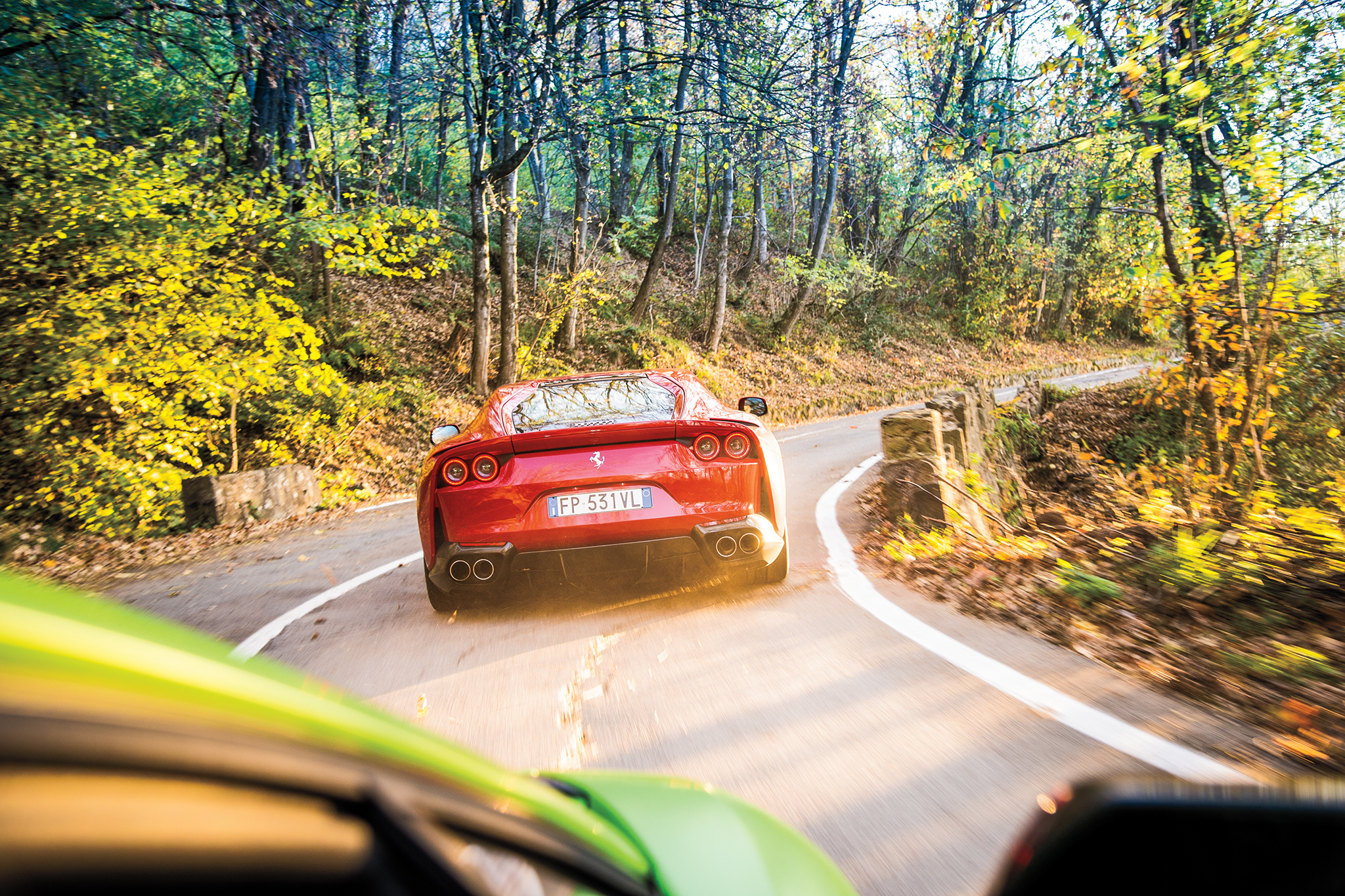
PT KONTAK PERKASA FUTURES - Over three days spent in these two 12-cylinder-powered Italian titans, snippets like these compile a pictorial travel diary inside your head. Other cast members: an aged woman sitting outside her home who responds to the sudden V-24 attack by instinctively reaching for—and missing—her fawning cat; the two Carabinieri who slip into Mille Miglia–inspired fasta! fasta! wave-through enthusiasm as soon as we roar into sight; the momentarily ambitious, tungsten-haired geezer in his SL63 AMG who drops behind so fast he subsequently pretends to have been on the phone all along; the teenage crazies on their scooters who’ll do anything to snatch a picture, rejoicing with thumbs-ups and high-fives when they do.
While a supercharged or twin-turbo V-8 can come close in terms of output and torque, the free-breathing 12-cylinder still rules the roost as far as throttle response, midrange pickup, and a fearless redline are concerned. It trades refinement for added raucousness, linearity for eruption, manners for raw performance. And although they share some striking similarities, the 12-pot unicorns from Maranello and Sant’Agata Bolognese—like the cars they propel—are quite different in character.
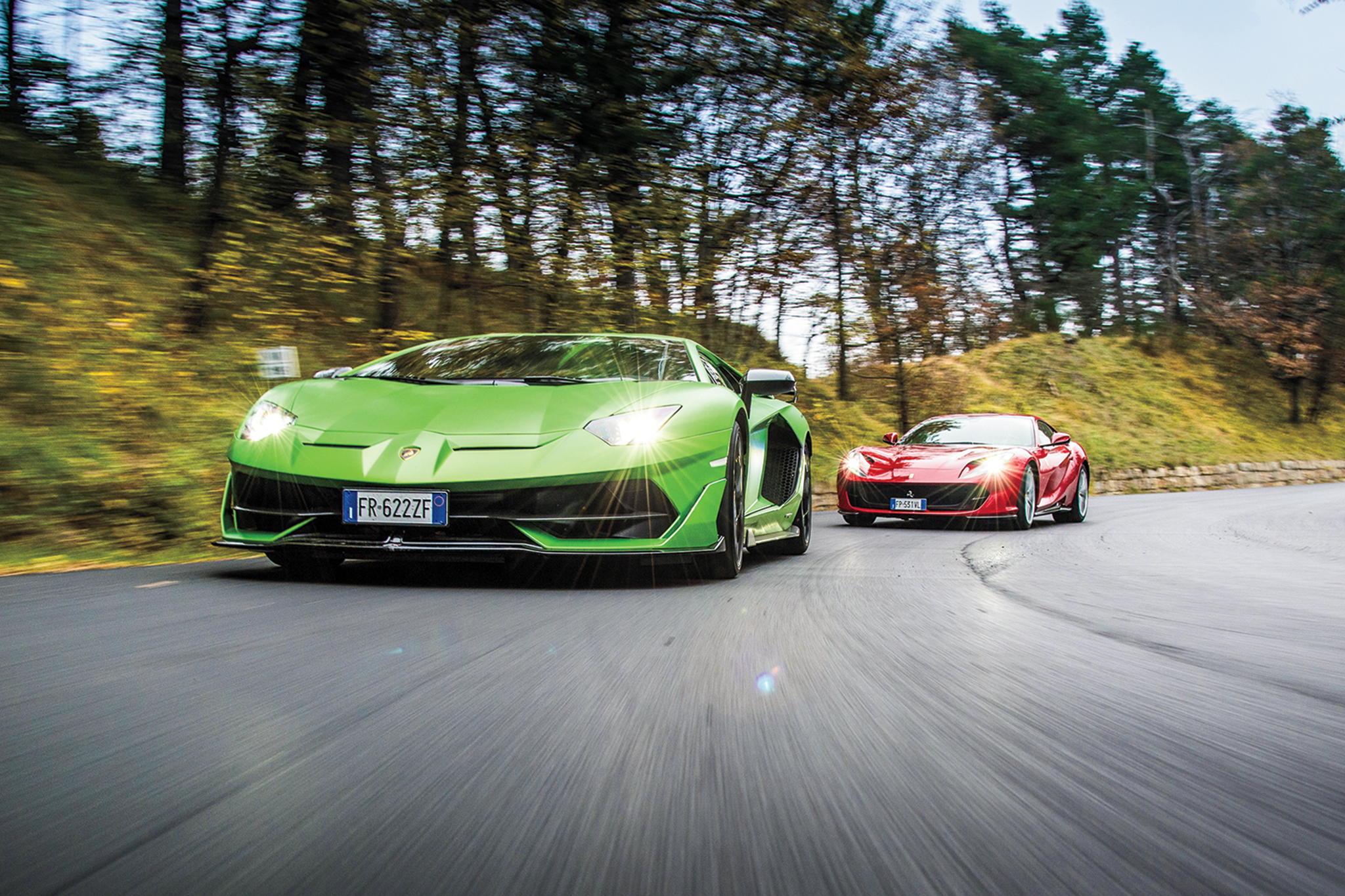
For reasons known only to the great engineer above
the clouds, the displacements of the two engines are virtually
identical, being just a single cubic centimeter apart, with the
Ferrari’s 6,469-cc edging out the Lambo’s mill. At 94.0 by 78.0
millimeters (Ferrari) and 95.0 by 76.4, bore and stroke are not far
apart, either. The same applies to their redlines, where the Superfast
eclipses its rival, spinning up to 8,900 rpm against the SVJ’s 8,700
rpm. Thanks to a notably higher compression ratio, a variable-rate
intake and exhaust system, and a more pronounced willingness to rev, red
beats green at the end of the day, with the car from Maranello
registering 789 horsepower against Sant’Agata’s 759, although it loses
the torque duel by the narrowest of margins, with the Ferrari V-12
making 530 lb-ft to the Lamborghini’s 531. Dry weight is somehow,
allegedly, exactly on par at 3,362 pounds.
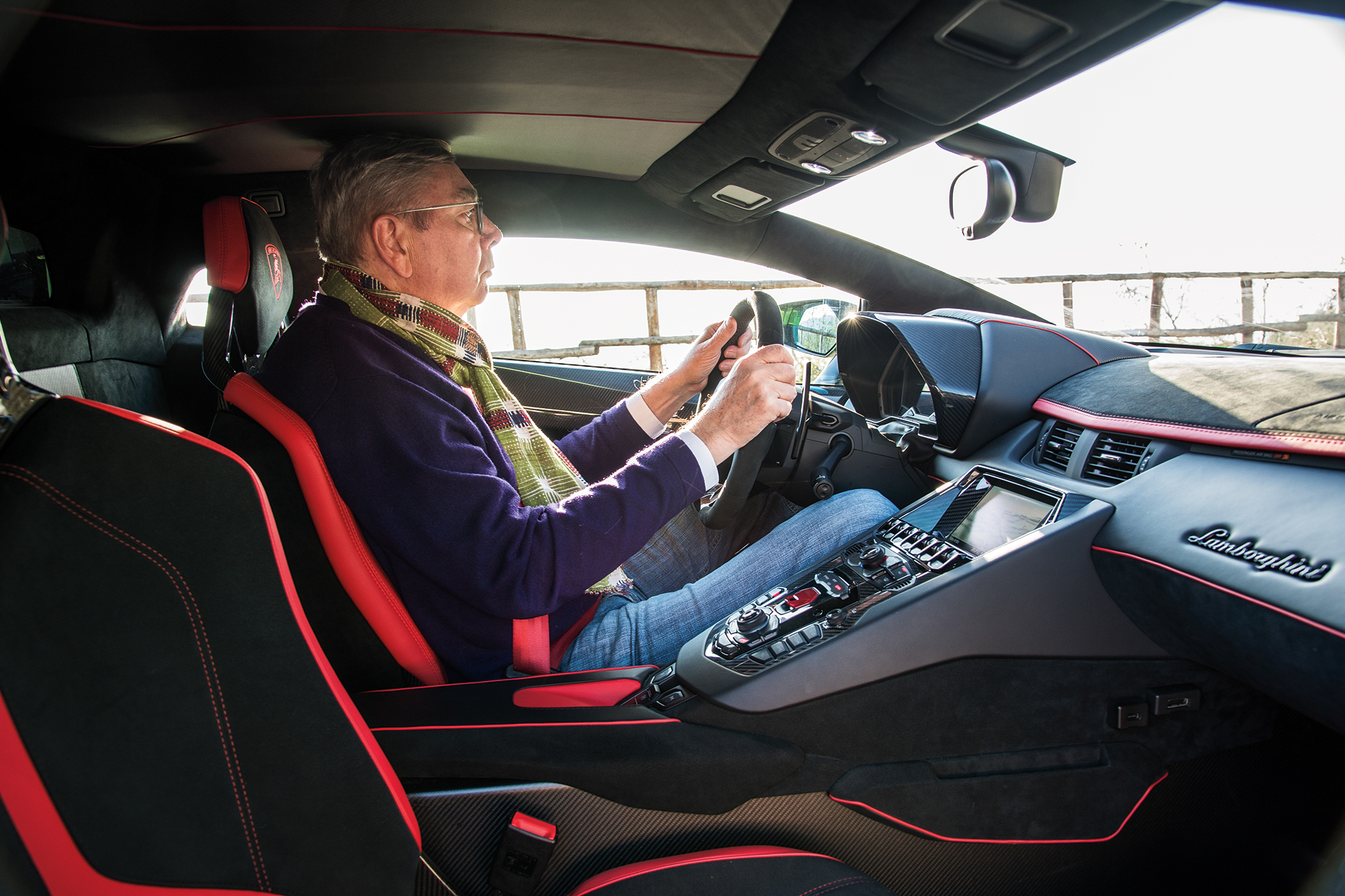
Which one’s quicker, you ask? Lamborghini says the
all-wheel-drive SVJ can launch to 62 mph in 2.8 seconds and hit 124 mph
in just 8.6 seconds, with a claimed top speed in excess of 219 mph.
While the rear-drive Ferrari 812 loses one-tenth to the Aventador in the
zero-to-62 sprint, it’s 0.7 second ahead by the time it arrives at the
124-mph marker onto its 211-mph terminal velocity. How does the Ferrari
get to 124 so much quicker than the SVJ? It’s all due to the Superfast’s
seven-speed dual-clutch transmission, which changes gears without
losing momentum. By contrast, the Aventador is handicapped by its jerky
and slow sequential ISG transmission.
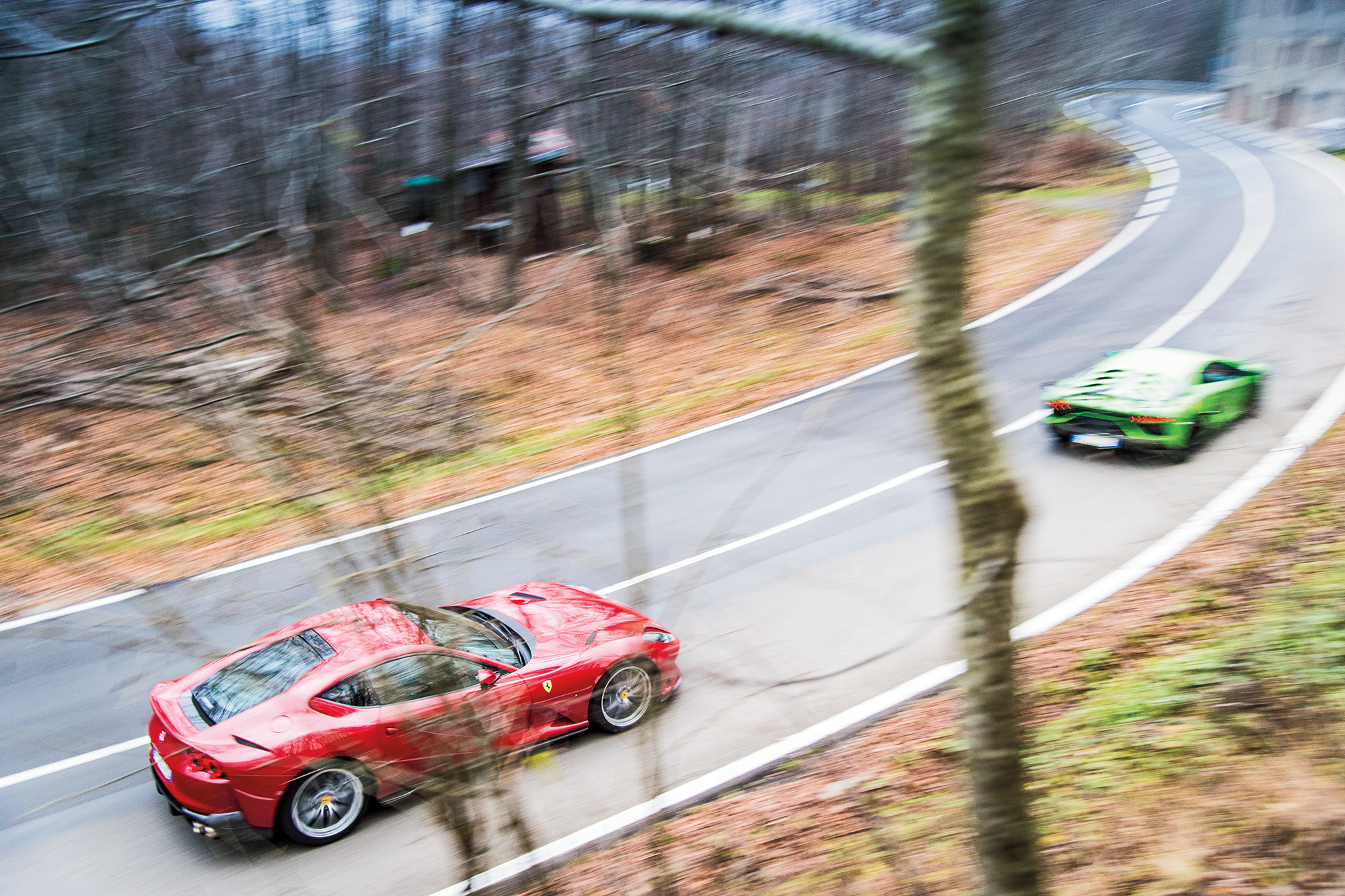
High
above Pistoia, in the heart of wild boar country northwest of Florence,
the time has finally come to fully arm our weapons. In the SVJ, the
right index finger lifts the red cage door that protects the
hell-breaks-loose button. In the 812, the red start-stop activator sits
within thumb’s reach on the busy steering wheel.
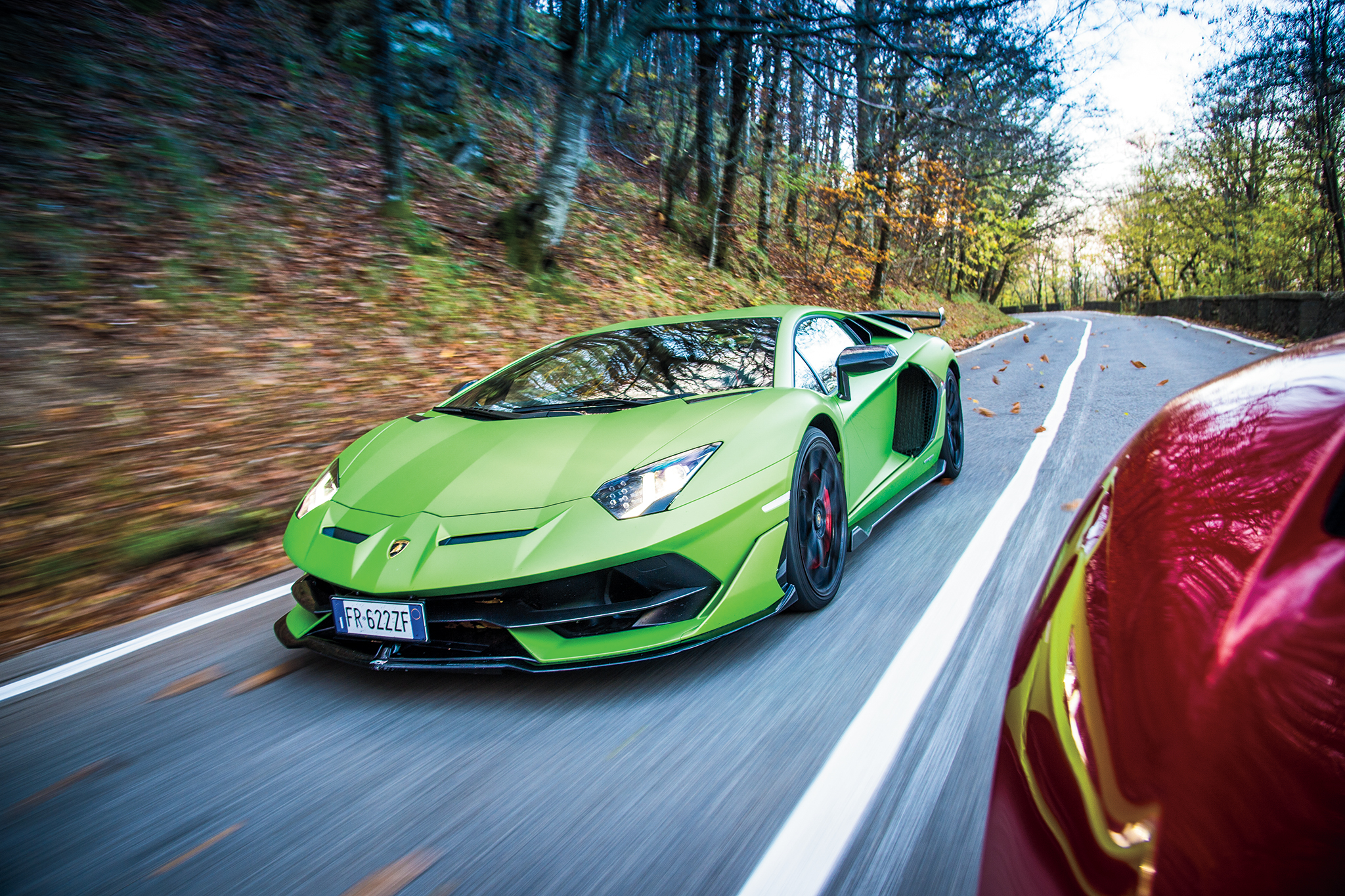
In
Auto and Sport mode, the 812’s transmission shies away from high revs
to the point that a vintage Giulia Super feels angrier and more
committed. In Manual mode, however, the rev symphony duly spirals gear
by gear, rising from the underhood orchestra pit with a recurrent
deafening roll of timpani. When pushed, both sports cars can be as noisy
as the law permits, but the Superfast avoids the harmonic oscillation
of the Aventador, which makes the Lamborghini’s completely cluttered and
thus largely useless rear window vibrate hard in its weather strips.
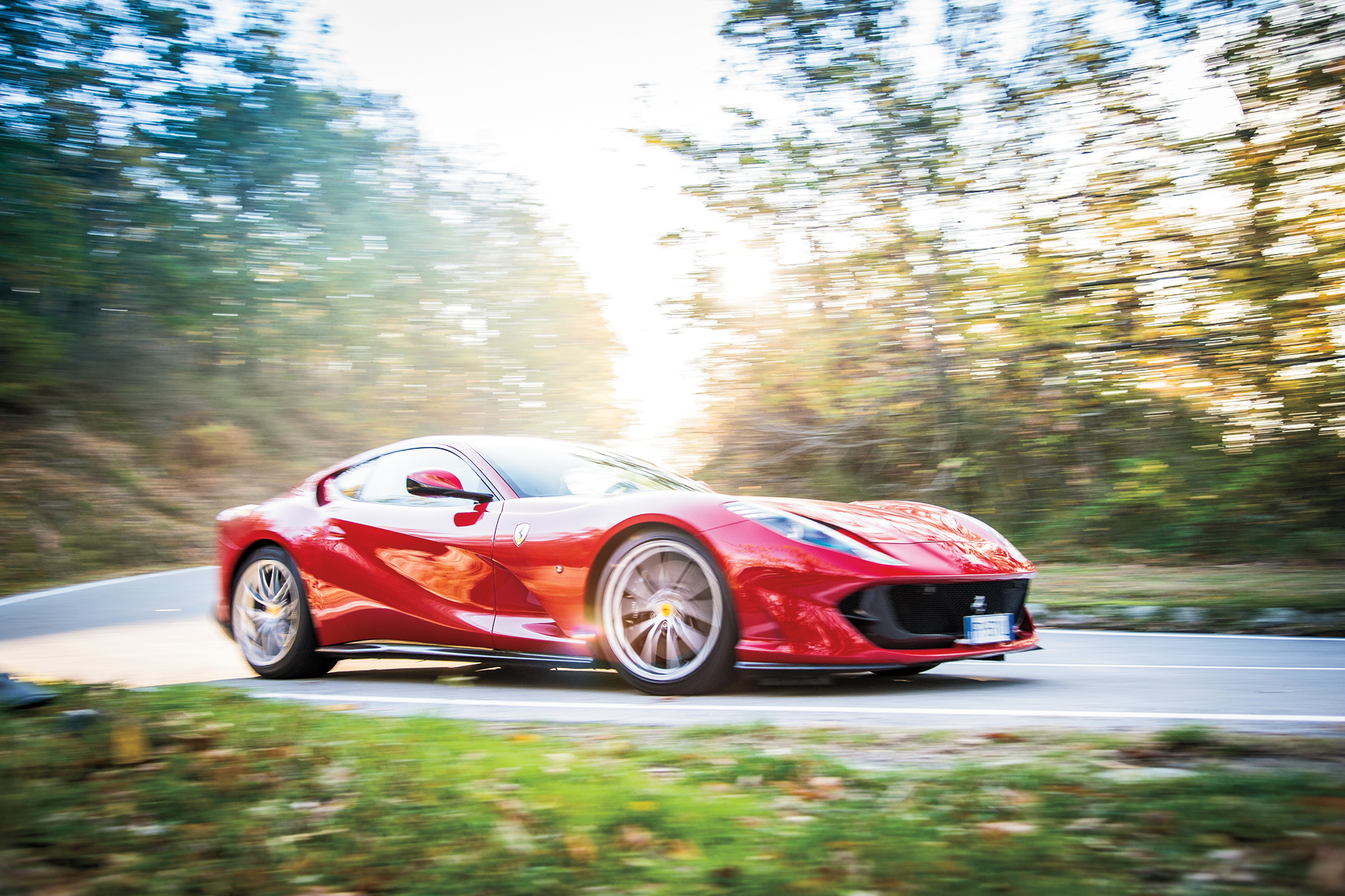
The 812 Superfast, which we just dubbed a 2019 Automobile All-Star,
encourages its driver to push ever deeper into tight bends, to test the
limits of lateral acceleration, to lay into the throttle with vigor
when appropriate, and to use steering and the gas pedal to gently adjust
the car’s delicate cornering balance. In second gear, the Ferrari
willingly lights impromptu bonfires close to the apex. In third, the
engine has oodles of oomph from one braking zone to the next. In fourth,
short straights are inhaled as a whole without pausing for breath. In
Race, full-throttle upshifts are so rogue it almost hurts, and the
brakes are simply sensational in terms of modulation, performance, and
repeatability.
In full attack mode, both coupes are prone to chatter teeth, wrench wrists, and crack spinal discs. Yet in contrast to the Lambo’s embryonic driving position, the Ferrari is almost a recliner on wheels. Even the racing seats come in three sizes, legroom is a relief, visibility could hardly be better, and the iconic manettino drive mode selector tweaks the car’s manners with aplomb in one easy click. Dislikes? A front end long enough to drop out of sight in dense fog, the fiddly secondary controls, and its RV-like turning circle.
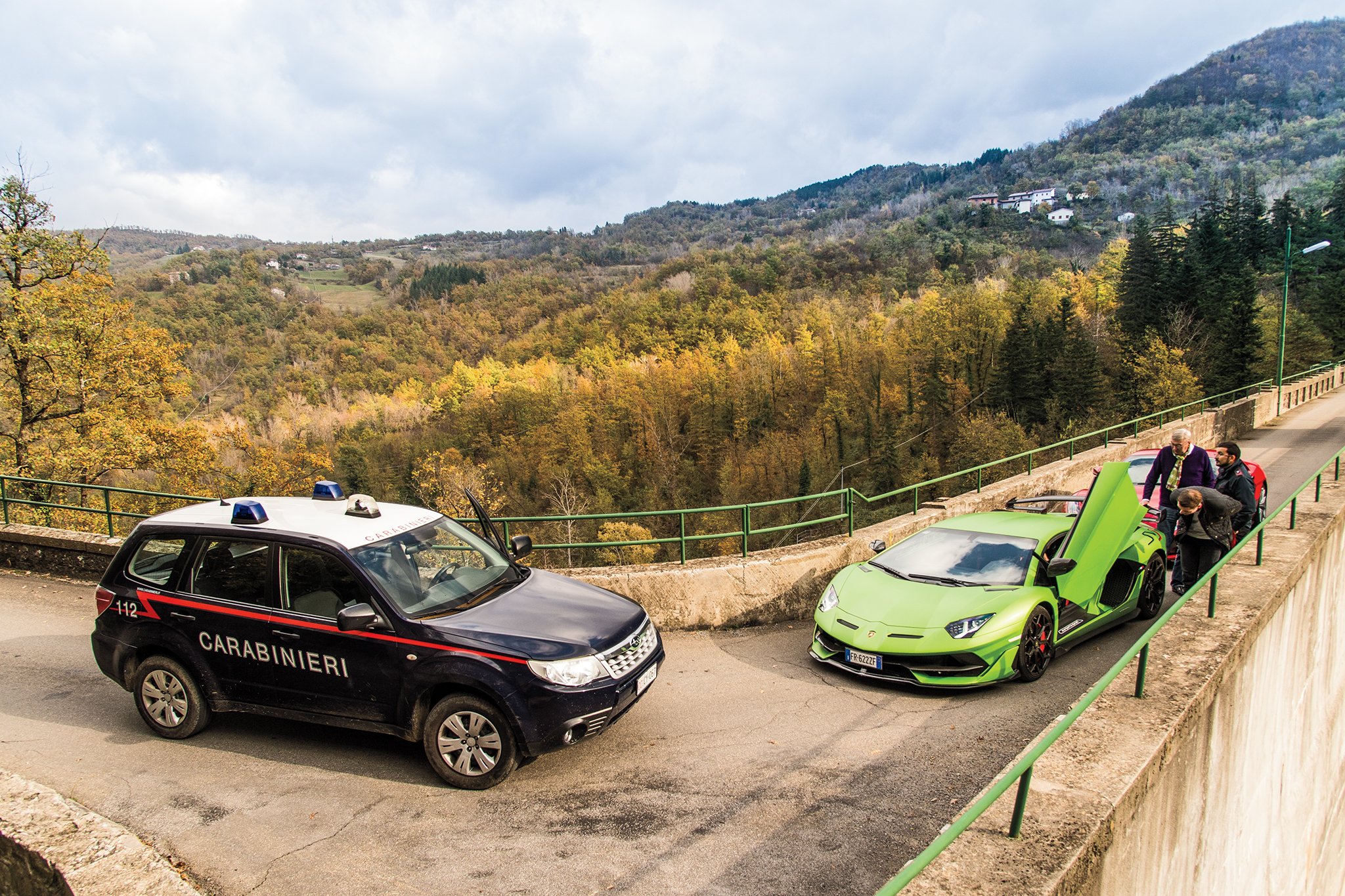
Neither car tolerates unfinished or neglected roads, crumbling curbs, yawning potholes, or the post-earthquake topography now typical of Umbria and the Marches. While the Ferrari softens its dampers at a button press, the most extreme Aventador bottoms out even in Strada (street) mode, to the point that the chassis control warning light comes on. For both cars, their natural dynamic domains are fast country roads and even faster highways where they can zigzag through traffic like invincible alien objects guided from a distant star.
“Life can’t get any better than this,” is the verdict after an insane 20-minute stint in the Lamborghini, the driver looking and feeling like a drenched wharf rat by the end. But then you jump in the Ferrari, and—mamma mia!—excitement and exhaustion are on exactly the same high level. True, these cars are as different as fish and fowl, but after 300 miles, the only quality that sets the 812 apart is about half an acre more cabin space.
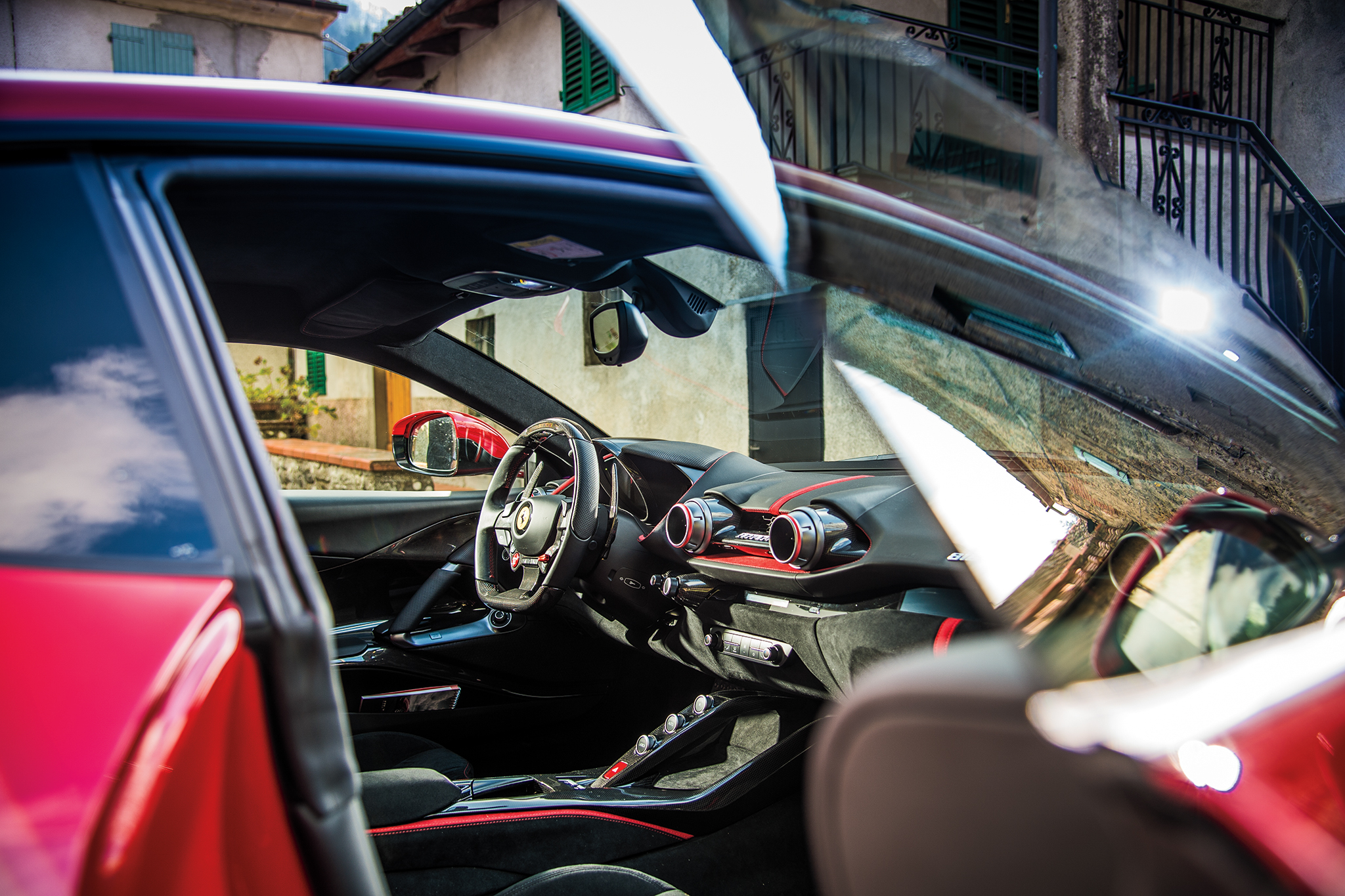
On the autostrada, the Aventador is a road shark
par excellence. Its silhouette in the mirror of the car ahead clears the
overtaking lane as effectively as would a rocket launcher. Its brakes
respond with the finality of a light switch. The heavy yet super-direct
steering works with micrometer precision. The active suspension lowers
and tightens the chassis at speed, and the active aero system (ALA) can
either increase downforce or reduce drag above 124 mph.
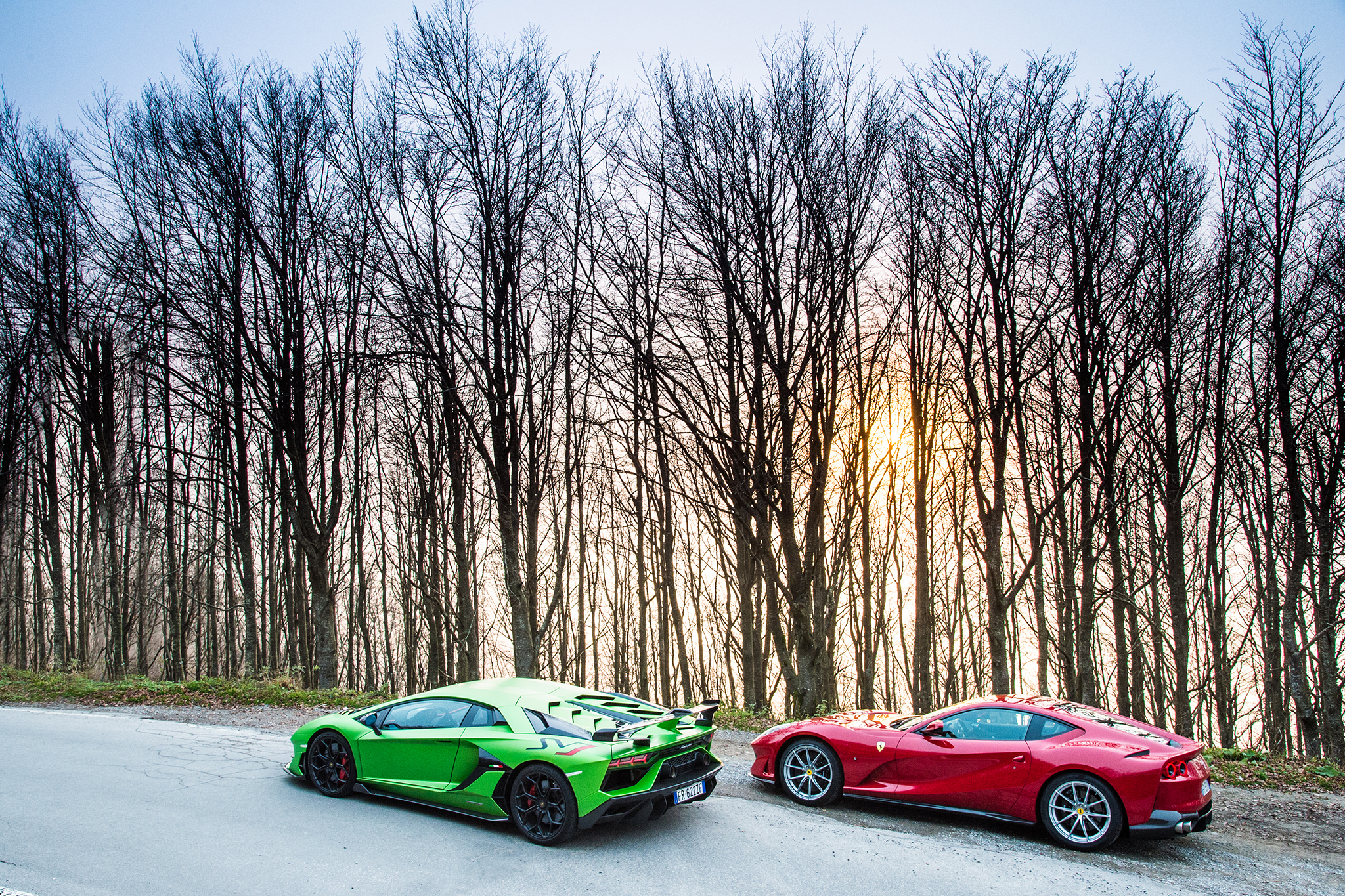
Choosing
between these two V-12s is as subjective as favoring red wine over
white, blond hair over black, classic music over pop. The Lambo engine
marks the ultimate evolution of a legend almost as old as the brand.
Despite modern details like cylinder cutoff and a variable valvetrain,
this bibulous powerplant fuses a clearly defined best-before date (EU7
emissions rules) with an unlimited excitement warranty. The Ferrari is
powered by a more advanced and more economical engine, but as soon as
the revs soar, it is every bit as explosive and resounding as the enemy
that warms up at the other end of the street. The future of cars in
general may be electric, but right now society is
still—thankfully—willing to turn a blind eye to standout hooligans like
these.
Source : automobilemag.com
- Get link
- X
- Other Apps
